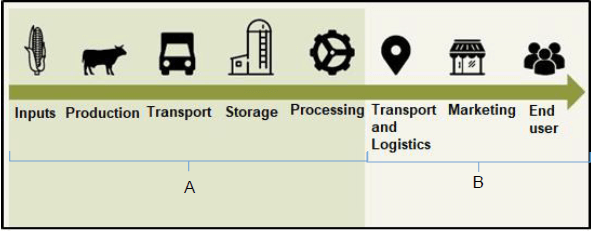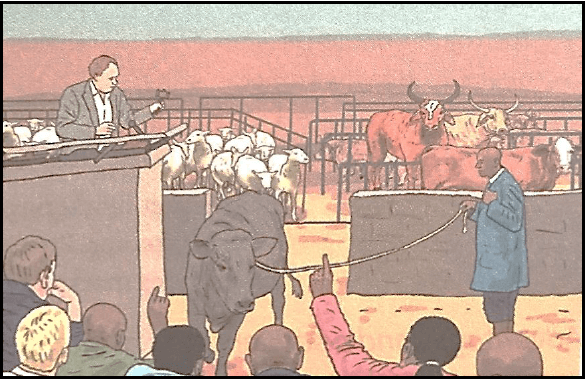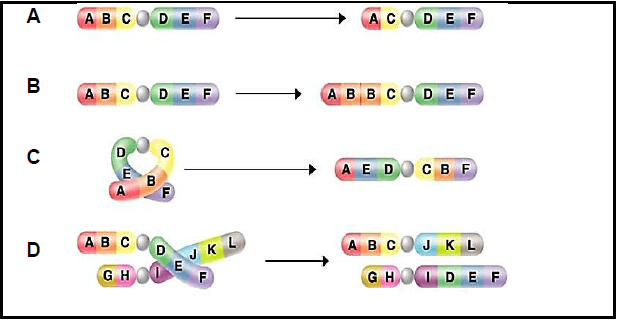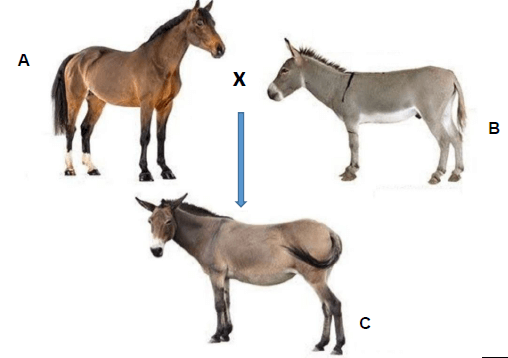Agricultural Sciences Paper 2 Questions - Grade 12 September 2021 Preparatory Exams
Share via Whatsapp Join our WhatsApp Group Join our Telegram GroupINSTRUCTIONS AND INFORMATION
- This question paper consists of TWO sections, namely SECTION A and SECTION B.
- Answer ALL the questions in the ANSWER BOOK.
- Start each question on a NEW page.
- Number the answers correctly according to the numbering system used in this question paper.
- You may use a non-programmable calculator.
- Show ALL calculations, including formulae, where applicable.
- Write neatly and legibly.
QUESTIONS
SECTION A
QUESTION 1
1.1 Various options are provided as possible answers to the following questions. Choose the correct answer and write only the letter (A–D) next to the question numbers (1.1.1–1.1.10) in the ANSWER BOOK, for example 1.1.11 D.
1.1.1 An Act of parliament that regulates employment contracts.
- Labour Relations Act
- Employment Equity Act
- Basic Conditions of Employment Act
- Occupational Health and Safety Act
1.1.2 The principle of management in which the manager checks whether results are achieved, and goals are reached.
- Control
- Planning
- Organising
- Directing
1.1.3 A risk management strategy ideal for an industry that is changing rapidly.
- Insurance
- Flexibility
- Specialisation
- Hedging
1.1.4 Products that are price inelastic in terms of demand:
- Are luxury items
- Have no substitutes
- Take a large portion of the consumer’s budget
- Are necessary goods
Choose the CORRECT combination:
- (i), (ii) and (iii)
- (i), (iii) and (iv)
- (i), (ii) and (iv)
- (ii), (iii) and (iv)
1.1.5 Which ONE of the following is not part of the marketing mix?
- Processing
- Product
- Price
- Place
1.1.6 The following statements apply to eco-labelling:
- Allows the consumers to see that the producer is using good agricultural practices
- It is used by organic farmers
- It is concerned with maximising profits
- It is a form of sustainable marketing
Choose the CORRECT combination:
- (i), (ii) and (iii)
- (i), (iii) and (iv)
- (i), (ii) and (iv)
- (ii), (iii) and (iv)
1.1.7 … is not an example of an agricultural co-operative.
- Purchasing co-operative
- Production co-operative
- Marketing co-operative
- Supply co-operative
1.1.8 The idea that for any particular trait, a pair of alleles of each parent separates and only one allele from each parent passes to an offspring is Mendel's principle of:
- Hybridisation
- Independent assortment
- Segregation
- Dominance
1.1.9 Sex-linked traits are more common in males than in females, because …
- all alleles on the X chromosome are dominant.
- all alleles on the Y chromosome are recessive.
- a recessive allele on the X chromosome will always produce the trait in a male.
- any allele on the Y chromosome will be co-dominant with the matching allele on the X chromosome.
1.1.10 A selection method that requires the most robust record-keeping regime for its successful implementation.
- Progeny
- Pedigree
- Mass
- Family (10 x 2) (20)
1.2 Choose a term/phrase from COLUMN B that matches a description in COLUMN A. Write only the letter (A–H) next to question numbers
(1.2.1 to 1.2.5) in the ANSWER BOOK, for example 1.2.6 I.
COLUMN A | COLUMN B | ||
1.2.1 | Responsible for quantitative characteristics | A | Multi segment marketing |
1.2.2 | Exist in a population when there are many variations of a gene present | B | Market segmentation |
1.2.3 | A marketing strategy where a company tries to gain customers from more than one type of market from the same product and uses | C | Cooperative marketing |
1.2.4 | Marketing of produce is based on a pool system | D | Poly genes |
1.2.5 | Effective combination and co- ordination of all resources to maximise profit | E | Multiple alleles |
F | Management | ||
G | Organising | ||
H | Prepotency | ||
(5 x 2) (10)
1.3 Give ONE word/term for each of the following descriptions. Write only the word/term next to the question numbers (1.3.1–1.3.5) in the ANSWER BOOK.
1.3.1 A mechanism of inheritance in which two dominant alleles are both expressed fully in the phenotype
1.3.2 The reappearance of an ancestral characteristic in an organism after the characteristic has been absent for many generations
1.3.3 The net amount of cash and cash equivalents being transferred into and out of the business
1.3.4 An agreement between participants on the same side in a market to collectively raise, lower or stabilise prices
1.3.5 A document that provides an estimate of expected income and expenditure for a given period of time (5 x 2) (10)
1.4 Change the UNDERLINED WORD(S) in each of the following statements to make them TRUE. Write only the answer next to the question numbers (1.4.1–1.4.5) in the ANSWER BOOK.
1.4.1 Mutation refers to differences that exist between individuals of the same species.
1.4.2 Marketing is the exchange of goods for cash.
1.4.3 Casual workers are employed to perform repetitive tasks on the farm.
1.4.4 A cash flow statement is a summary of the assets and liabilities of a business.
1.4.5 Net worth refers to money or equipment saved or accumulated by the farmer to use in the production process. (5 x 1) (5)
TOTAL SECTION A: 45
SECTION B
QUESTION 2: AGRICULTURAL MANAGEMENT AND MARKETING
Start this question on a NEW page.
2.1 The table below shows the demand and supply of peaches.
Price (R) | Quantity supplied (kg) | Quantity Demanded (kg) |
7 | 80 | 30 |
6 | 70 | 45 |
5 | 60 | 60 |
4 | 50 | 75 |
3 | 40 | 90 |
2 | 30 | 105 |
1 | 20 | 120 |
2.1.1 Name the condition that exists in the market at R5. (1)
2.1.2 Deduce the law of supply from the table above. (2)
2.1.3 Give TWO factors that could have affected the demand of peaches in the table above. (2)
2.1.4 Draw a line graph to show the quantity of peaches demanded in the table above. (6)
2.2
2.2.1 Provide a caption for the diagram above (1)
2.2.2 Divide the diagram above into two sections by providing the labels A and B. (2)
2.2.3 Identify THREE marketing functions in the diagram above. (3)
2.2.4 Suggest TWO ways of making the process above more efficient. (2)
2.3 Below are the different types of buyers on agricultural markets in South Africa.
| Retailers; Consumers, Food processing companies;Exporters and importers; Brokers |
Identify the type of buyers for each of the following:
2.3.1 Companies that buy and sell agricultural products in foreign markets. (1)
2.3.2 These agents work for commission on behalf of other participants. (1)
2.3.3 Individuals or companies that buy fresh and processed foods for final use. (1)
2.3.4 Enterprises that use agricultural commodities as raw materials. (1)
2.3.5 Intermediaries, which include supermarkets, who divide up large shipments of produce and sell them to end users. (1)
2.4 The image below shows a marketing channel that is popular with farmers.
2.4.1 Name the marketing channel illustrated above. (1)
2.4.2 Name the marketing system associated with the marketing channel. (1)
2.4.3 Justify the use of the marketing channel above by farmers by giving TWO reasons. (2)
2.4.4 List TWO other channels, except the one stated in QUESTION 2.4.1, that farmers can use to market produce. (2)
2.5
| Entrepreneurs are individuals who are willing and able to convert a new idea into a successful business. To start new businesses, entrepreneurs need to develop a business plan. |
2.5.1 Define the underlined phrase in the passage. (2)
2.5.2 Give TWO reasons why the document mentioned above is important. (2)
2.5.3 Give ONE entrepreneurial success factor. (1)
[35]
QUESTION 3: PRODUCTION FACTORS
Start this question on a NEW page.
3.1
3.1.1 Define the term land. (2)
3.1.2 Identify TWO economic functions of land shown above. (2)
3.1.3 Give TWO economic characteristics of land as a production factor. (2)
3.1.4 Suggest TWO measures a farmer can take to improve the productivity of the land shown in B. (2)
3.2
| From 1985 until 2009, 11 million labourers in agriculture died of HIV/Aids related diseases. Most of the victims were in their prime, that is 20-years of age. People in this age bracket should be economically active and producing at full capacity. |
3.2.1 Identify the problem associated with labour described in the passage above. (1)
3.2.2 Recommend TWO measures farmers can take to reduce the threat of the problem mentioned above. (2)
3.2.3 State TWO other problems associated with labour in agriculture, that are not mentioned in the passage above. (2)
3.2.4 Give TWO strategies that can be employed by farmers to improve labour productivity. (2)
3.3 A farmer wants to go into tomato production. The farmer decided to draft the budget below to determine the viability of tomato production.
Income | Amount (R) |
300 kg at R7,00/kg | 2 100,00 |
Expenses | |
Seed | 100 |
Fertiliser and lime | 700 |
Machinery fuel | 600 |
Irrigation | 450 |
Harvesting | 100 |
Labour | 300 |
Miscellaneous | 200 |
Insurance | 100 |
Profit/Loss | ………. |
3.3.1 Identify the budget shown above. (1)
3.3.2 Identify ONE variable cost from the budget shown above. (1)
3.3.3 Justify your answer to QUESTION 3.3.2 above. (2)
3.3.4 Calculate the profit/loss. (3)
3.3.5 Deduce with a reason whether this enterprise is viable. (2)
3.4 The table below shows a piece of a farm record.
Asset | Number | Make | Model | Year |
Apple sorters and graders | ||||
Brooder stoves | ||||
Combines and threshers | ||||
Corn pickers | ||||
Cultivators | ||||
Fertiliser and lime spreader | ||||
Harrows – Disc | ||||
Harrows – Spike tooth | ||||
Harrows – Spring tooth | ||||
Irrigation pump | ||||
Incubators | ||||
Tractors |
3.4.1 Identify the farm record shown above. (1)
3.4.2 Motivate the importance of such records on farms. (1)
3.4.3 State the type of capital in the farm record above. (1)
3.4.4 Identify the problem associated with capital that is unique to the type of capital above. (1)
3.4.5 Mention TWO methods that can be used to create capital. (2)
3.5
| An orange juice manufacturing company has been in business for 30 years, as a result it has a highly skilled workforce. The challenge, however, is the aging equipment and increased competition from recently established companies. |
3.5.1 Identify ONE internal and ONE external force affecting the company in the passage above. (2)
3.5.2 Identify the type of risk that is faced by this company due to the challenges mentioned above. (1)
3.5.3 Explain how the company’s internal and external forces lead to the risk mentioned in QUESTION 3.5.2. (2)
[35]
QUESTION 4: BASIC AGRICULTURAL GENETICS
Start this question on a NEW page.
4.1
| In pea plants, spherical seeds (R) are dominant over dented seeds (r). In a genetic cross a plant that is heterozygous for the seed shape trait is self- pollinated. |
4.1.1 Use a punnet square to show the cross described above. (4)
4.1.2 Determine the genotypic ratio. (1)
4.1.3 Calculate the probability of spherical seeds being produced from the cross above. (3)
4.1.4 Deduce with a reason the type of dominance in the cross. (2)
4.1.5 Deduce whether the seed shape is a quantitative or qualitative characteristic. (1)
4.1.6 Motivate your answer to QUESTION 4.1.5 above. (1)
4.2 
4.2.1 Classify the mutations above as chromosomal or gene mutations. (1)
4.2.2 Identify the mutations B, C and D. (3)
4.2.3 The process shown above results in variation. Give TWO reasons why variation is important in agriculture. (2)
4.2.4 Give ONE example of a physical agent that can cause the changes depicted above. (1)
4.3
4.3.1 Identify animal C in the diagram above. (1)
4.3.2 Identify the breeding system depicted above. (1)
4.3.3 Motivate your answer to QUESTION 4.3.2 above. (2)
4.3.4 Describe TWO benefits of animal C, over animal A. (2)
4.3.5 Give TWO disadvantages of this breeding system. (2)
4.4
| In the last 15 years, GM crop producing countries, have benefited from adoption of this new technology in the form of improved crop productivity, food security. The increased income to resource-poor farmers is a key benefit at the individual level, especially as most countries using this technology are in the developing world, including three African countries (South Africa, Burkina Faso and Egypt). Despite clear benefits to countries and farmers who grow GMOs, many people are concerned about suspected potential risks associated with GMOs. |
4.4.1 Identify the plant improvement method described in the passage above. (1)
4.4.2 Give ONE advantage of this technology that is mentioned in the passage above. (1)
4.4.3 Give TWO advantages of the plant improvement method in QUESTION 4.4.1 over traditional methods. (2)
4.4.4 Describe TWO current applications of this technology in plants. (2)
4.4.5 Mention TWO human health risks of GMOs. (2)
[35]
TOTAL SECTION B: 105
GRAND TOTAL: 150